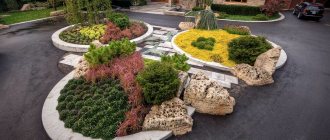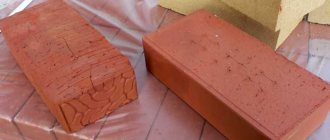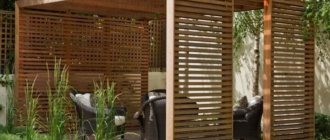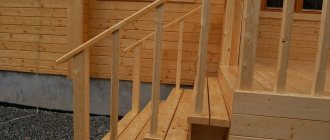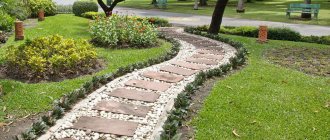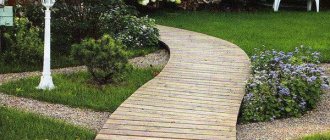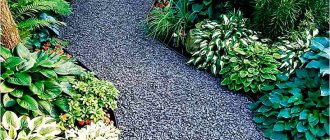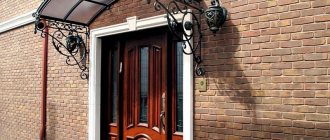A flowerbed fence is a necessity for a flowerbed in which tall or medium-sized plants are planted. Such a fence supports the flowers and prevents the bushes from falling apart.
Flower beds with low-growing plants have their own fences - borders that clearly delimit the flower area and do not allow the plants to “spread”.
Many fences for flower beds and flower beds perform mainly functional tasks. Visually, they are restrained, strict and simple, giving way to flowers as the main decor of the flowerbed. But there are flower fences and fences that can turn the simplest flower bed with simple plants into a masterpiece of landscape art.
Store-bought flower bed fences are good and easy to install, but homemade flower fencing is also beneficial. They:
- cheap, often do not require any investments at all, since they are collected from materials that are available;
- unique, you can make a fence, thanks to which the flowerbed in the landscape of your garden will look amazing.
Fence for flower beds made of concrete slabs
Interesting fences from concrete tiles are easy to make. Take a closer look: each such tile has a metal pin with which it is fixed in the ground.
- We find square or rectangular molds for making tiles - these can be various plastic containers or even cardboard milk boxes cut lengthwise.
- On one side, each mold will have to be cut to insert the pins (a metal rod can be used).
- Lubricate the inside of the mold with some kind of oil (drying oil or car polish works great).
- Pour the solution into the molds and wait a day for the solution to set.
- We take out the products along with the pins attached to them.
- We send it to dry in partial shade.
- If you want white tiles, you can use Portland cement. In principle, tiles can be painted in any color with facade paint.
Made of stone and brick
The area of tall shrubs can be separated from the lawn using cobblestones of any shape and size. You can build a low fence from such cobblestones if you fasten the stones with concrete.
This material is often used in the design of flower beds; with its help, you can give the flower garden smooth, wavy and rounded lines, unlike wooden or metal structures.

Decorative stone looks beautiful for fencing a flower bed Source kosovamanagement.com
Advice: if you are filling a flower garden with gravel, initially lay a film under it, preferably roofing material. To prevent the weed from germinating, the stones were not clogged with weeds. The seeds that arrive from above will not be missed by the film and will not allow roots to sprout. This way the stones will always be clean.
Of course, such material will not be durable, since over time it will accept natural seedlings deep into the soil, despite the fact that the fences will not initially be high. But such a fence will definitely not rot. It can be replaced and updated at any time.
Made of brick
The fence for the flower bed can be laid out with bricks that are slightly inclined towards each other.
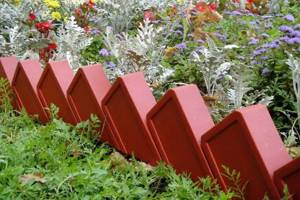
Just make a masonry Source polimersad.ru
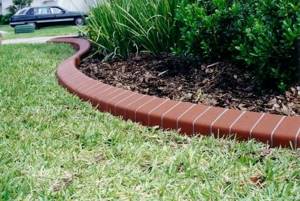
Brick border laid horizontally Source pinterest.com
How to make a wicker fence for a flower bed
For a wicker fence, the main thing is to prepare suitable rods. The material can be cut in the spring, choosing the most flexible tree branches. If the fence is small, weaving can be made from branches of fruit trees and shrubs - apple trees, plums, pears, grapes, currants, etc. Process: stick stakes around the flower bed and braid them with twigs (through one peg, staggered in rows).
↑ Varieties
The criteria for classifying garden fencing are usually the height and type of material used. When choosing the height of a structure, the purpose and class of cultural plantings are taken into account. For example, for a flower bed planted with viola or pansies, a low, neat structure is perfect. If the flower garden consists of tall peonies, roses or dahlias, use a larger fence.
Recommendations from experienced designers:
- To carry out zoning of a personal plot, to focus on the flower garden and separate it from other elements, use a low fence of 5-7 cm.
- To protect against soil subsidence, heavy curbs are made of high-strength materials. The height of such structures is usually 10-15 cm.
- In cases where there is a threat of plant roots spreading beyond the contour of the flower bed, it is better to use stone or plastic to make a fence. The structure itself must be dug into the soil.
- A tall structure of 50 cm or more will protect plants from encroachment by animals and children. Also, such fences can act as a support for tall crops.
- To highlight the flower garden against the background of the surrounding landscape, it is recommended to use a raised flower bed. To cover its foundation, the use of brick or stone is allowed. Thus, the structure receives additional resistance to operational loads.
Stylish fence for a flower bed made of reinforcing rods
- We stick reinforcing rods or sections of thin metal pipe into the ground.
- We secure the crossbar with wire along the top of the pins (as can be seen in the picture). You can fasten the rods in another way, tying the place of contact with wire crosswise.
- It is advisable to surround such a fence with stones, paving stones, etc.
Dry twig fencing
Wicker fences look very cute and economical. But making such a fence will take some time and a little effort. However, this is not so significant, because in the end you will get a fantastic result that will delight you for many years.
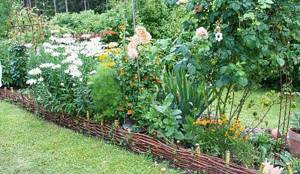
Loading…
Material for wicker fencing is quite easy to obtain. All you need to do is go to any body of water and collect willow twigs. It is best to harvest them in early spring. At this time, the bark can be easily separated from the main vine. This is necessary so that the fence is much stronger and has a nice light shade.
When the preparatory work has passed, you can begin the production itself. Before you start weaving, it is important to make all the twigs the same length. Next, thick pegs, approximately 3 centimeters in diameter, must be evenly installed along the entire perimeter of the lawn or flower bed. The distance between the supporting stakes depends on the degree of strength you want to obtain for the fence. Then everything is simple: the installed pegs are braided according to a basket weaving pattern. The number of rows depends only on how high the fence should ultimately be. For a better effect, after completing the weaving, you can additionally secure the twigs with nails.
Brick fence for flower beds
You will need a little brick and mortar, but the fence will be solid and will last for a long time.
First, about the solution : mix 1 part cement with 3 parts sand, pour water in parts, stirring all the time. When the consistency of the mass becomes like a thick cream, the solution is ready.
- We mark the place for the flower bed.
- We tear off a groove of small depth (about 30 cm).
- We fill the ditch with sand and crushed stone.
- Fill with solution.
- The result was a light foundation. You can not fill the foundation, but simply pour crushed stone (drainage) and start laying the brick walls of the fence in the recess.
- 2-3 rows of bricks above the ground, and the fence is ready.
Exactly the same fence can be made from any building blocks.

More fences for flower beds made of brick and stone
Types of homemade fencing for flower beds
We propose to consider the most popular fences for flower beds with your own hands from scrap materials, which are very easy to create with your own hands.
From stones
The most popular border for a flower bed using improvised means is made of stones.
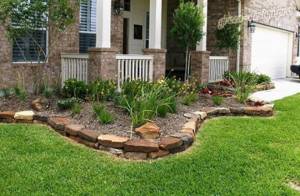
At the first stage of creation, the layout and height of the fence are determined. Then the foundation is prepared (if a tall structure is planned). Along the contour of the flower bed, they dig a trench 30 cm deep and a width corresponding to the size of the stones. Then the ditch is waterproofed using polyethylene, then concrete is poured and left to dry. Low, beautiful fences for flower beds with your own hands do not require pouring a foundation.
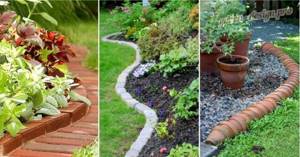
The next stage is laying the stone with fastening using thick cement mortar. To ensure the process is carried out smoothly, use a building level.
You can also check out “Original do-it-yourself flower bed made of stones”
Wooden fence for flower beds
Miniature fences made of wooden materials look beautiful on the territory.
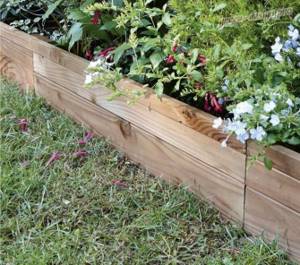
Wooden boards fit harmoniously into the design of flower beds
A variety of boards, plinths, platbands or various types of wood materials are suitable for creation; they will organically complement medium-sized crops.
Process of creation:
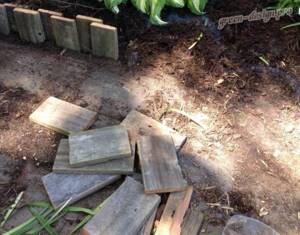
- We decide on the height, mark it on the base, and saw off boards of identical sizes.
- In order for the workpieces to be conveniently fixed to the ground, an acute angle is made on one side, while the top is left straight.
- The prepared pegs are dug or driven into the ground 5-10 cm so that they are as strong as possible. The average height of the workpiece is 35 cm.
The advantage of such a fence is its original shape. But to achieve the perfect result, you will need to use a level to set the line as straight as possible.
Plastic fences for flower beds
The advantage of a garden plastic fence is that you can reproduce different original shapes on your site.
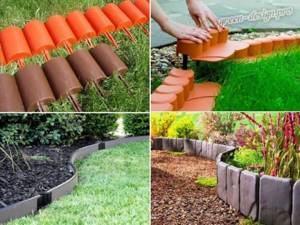
You can also build borders using plastic bottles. They can be painted in multi-colored colors or covered with plain paint. After this, sand is poured into the bottles so that they do not deform from exposure to high temperatures. Then they are placed in the ground according to the invented scheme or arrangement of plants.
Metal fencing for flower beds
Forged or stamped fences will work well here.
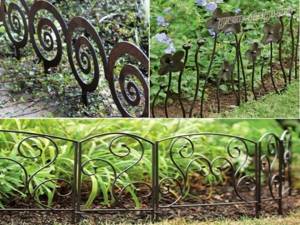
If you decide to create a metal fence with your own hands, then pay attention to the old pipes that are welded together. You can use unnecessary bicycle frames or wheels. A corrugated sheet of metal cut into strips is also suitable as a fence.
Glass fencing options
Beautiful fencing for flower beds can be easily created with your own hands from glass bottles.
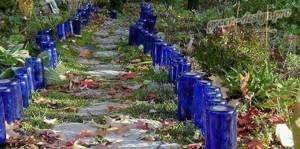
To do this, prepare empty bottles of champagne, wine or beer. The creation process is very simple - collect the required number of containers (for example, for a medium-sized plot, 20-25 pieces will do). After this, dig a low hole and stick the bottles in there so that the neck is in the ground. To create a beautiful horizontal line, use a building level.
Vine
This type of fence looks very elegant, and its creation does not take much time. To make fences, use the following diagram:
- Drive base stakes into the ground at a distance of 10-20 cm, and cover the space between them with vines.
- To make the fence stable, secure it with fishing line. The height of the structure depends on the number of rows located.

Such structures are harmoniously combined with various landscape styles, and if you treat the surface with paint, you can significantly extend the service life of the products.
Slate
Slate is durable, and thanks to its wave shape, it allows you to create an original garden design.
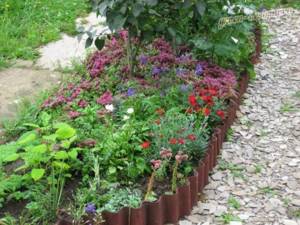
To build the structure, the slate is first cut into 2 parts. For this it is better to use a grinder. According to the contours of the flower bed, they dig a small narrow groove and place the slate plates made there. Then they are sprinkled with soil, and small, inconspicuous pegs are installed to strengthen them.
Fencing made from old plates
Do-it-yourself small fences for flower beds are made from old dishes. Unnecessary saucers will be a wonderful addition to the flower garden. To decorate the area, simply stick the plates into the soil or cement solution. The advantage of this solution is simplicity, long service life, and unusual design.
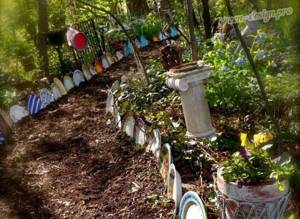
Having learned how to make beautiful fences for flower beds with your own hands, you will be able to complement the garden with original fences, zone the space, and protect the plants.
Wooden fences for flower beds
Border tape for flower beds
A simple, budget-friendly solution for fencing a low flower bed is border tape .
